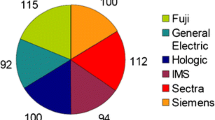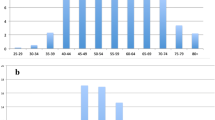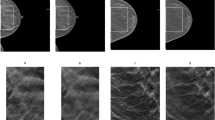Abstract
The purpose of this study was to develop and evaluate a computerized method of calculating a breast density index (BDI) from digitized mammograms that was designed specifically to model radiologists’ perception of breast density. A set of 153 pairs of digitized mammograms (cranio-caudal, CC, and mediolateral oblique, MLO, views) were acquired and preprocessed to reduce detector biases. The sets of mammograms were ordered on an ordinal scale (a scale based only on relative rank-ordering) by two radiologists, and a cardinal (an absolute numerical score) BDI value was calculated from the oridinal ranks. The images were also assigned cardinal BDI values by the radiologists in a subsequent session. Six. mathematical features (including fractal dimension and others) were calculated from the digital mammograms, and were used in conjunction with single value decomposition and multiple linear regression to calculate a computerized BDI. The linear correlation coefficient between different ordinal ranking sessions were as follows: intraradiologist intraprojection (CC/CC):r=0.978; intraradiologist interprojection (CC/MLO):r=0.960; and interradiologist intraprojection (CC/CC):r=0.968. A separate breast density index was derived from three separate ordinal rankings by one radiologist (two with CC views, one with the MLO view). The computer derivedBDI had a correlation coefficient (r) of 0.907 with the radiologists’ ordinalBDI. A comparison between radiologists using a cardinal scoring system (which is closest to how radiologists actually evaluate breast density) showedr=0.914. A breast density index calculated by a computer but modeled after radiologist perception of breast density may be valuable in objectively measuring breast density. Such a metric may prove valuable in numerous areas, including breast cancer risk assessment and in evaluating screening techniques specifically designed to improve imaging of the dense breast.
Similar content being viewed by others
References
Wolfe JN: Breast patterns as an index of risk for developing breast cancer. AJR Am J Roentgenol 126:1130–1137, 1976
Wolfe JN: Risk for breast cancer development determined by mammographic parenchymal pattern. Cancer 37:2486–2492, 1976
Boyd NF, Byng JW, Jong RA, et al: Quantitative classification of mammographic densities and breast cancer risk: results from the Canadian National Breast Screening Study. J Natl Cancer Inst 87:670–675, 1995
Feig SA, Yaffe MJ: Digital mammography, computeraided diagnosis, and telemammography. Radiol Clin North Am 33:1205–1230, 1995
Yaffe MJ: Direct digital mammography using a scanned-slot CCD imaging system. Med Prog Technol 19:13–21, 1993
Feig SA: The role of ultrasound in a breast imaging center. Semin Ultrasound CT MR 10:90–105, 1989
Guyer PB, Dewbury KC: Ultrasound of the breast in the symptomatic and X-ray dense breast. Clin Radiol 36:69–76, 1985.
Graham SJ, Bronskill MJ, Byng JW, et al.: Quantitative correlation of breast tissue parameters using magnetic resonance and X-ray mammography. Br J Cancer 73:162–168, 1996
Dash N, Lupetin AR, Daffner RH, et al.: Magnetic resonance imaging in the diagnosis of breast disease. AJR Am J Roentgenol 146:119–125, 1986
Turner DA, Alcorn FS, and Adler YT: Nuclear magnetic resonance in the diagnosis of breast cancer. Radiol Clin North Am 26:673–687, 1988
Jansson T, Westlin JE, Ahlstrom H, et al: Positron emission tomography studies in patients with locally advanced and/or metastatic breast cancer: A method for early therapy evaluation? J Clin Oncol 13:1470–1477, 1995
Wahl RL, Zasadny K, Helvie M, et al: Metabolic monitoring of breast cancer chemohormonotherapy using positron emission tomography: Initial evaluation. J Clin Oncol 11:2101–2111, 1993
Rambaldi PF, Mansi L, Procaccini E, et al: Breast cancer detection with Tc-99m tetrofosmin. Clin Nucl Med 20:703–705, 1995
Takahashi T, Moriya E, Miyamoto Y, et al: The usefulness of 201T1C1 scintigraphy for the diagnosis of breast tumor. Nippon Igaku Hoshasen Gakkai Zasshi 54:644–649, 1994
Wolfe JN: Developments in mammography. Am J Obstet Gynecol 124:312–323, 1976
Wolfe JN, Albert S, Belle S, et al: Breast parenchymal patterns: Analysis of 332 incident breast carcinomas. AJR Am J Roentgenol 138:113–118, 1982
Wolfe JN, Albert S, Belle S, et al: Breast parenchymal patterns and their relationship to risk for having or developing carcinoma. Radiol Clin North Am 21:127–136, 1983
Wolfe JN, Saftlas AF, Salane M: Mammographic parenchymal patterns and quantitative evaluation of mammographic densities: a case-control study. AJR Am J Roentgenol 148:1087–1092, 1987
Rockette HE, Gur D, Metz CE: The use of continuous and discrete confidence judgments in receiver operating characteristic studies of diagnostic imaging techniques. Invest Radiol 27:169–172, 1992
Press WH, Fannery BP, Teukolsky SA, et al: Numerical Recipes in C: The Art of Scientific Computing. Cambridge, Cambridge University Press, 1988
Astion ML, Wilding P: The application of backpropagation neural networks to problems in pathology and laboratory medicine. Arch. Pathol Lab Med 116:995–1001, 1992
Gurney JW: Neural networks at the crossroads: Caution ahead. Radiology 193:27–28, 1994
Wu Y, Giger ML, Doi K, et al: Artificial neural networks in mammography: Application to decision making in the diagnosis of breast cancer. Radiology 187:81–87, 1993
Floyd CE, Tourassi GD: An artificial neural network for lesion detection on single-photon emission computed tomographic images. Invest Radiol 27:667–672, 1992
Asada N, Doi K, MacMahon H, et al: Potential usefulness of an artificial neural network for differential diagnosis of interstitial lung diseases: Pilot study. Radiology 177:857–860, 1990
Tourassi GD, Floyd CE, Sostman HD, et al: Artificial neural network for diagnosis of acute pulmonary embolism: Effect of case and observer selection. Radiology 194:889–893, 1995
Morin RL: Monte Carlo Simulation in the Radiological Sciences. Boca Raton, FL, CRC Press, 1988
Caldwell CB, Stapleton SJ, Holdsworth DW, et al: Characterisation of mammographic parenchymal pattern by fractal dimension. Phys Med Biol 35:235–247, 1990
Dorfman DD, Berbaum KS, Metz CE: Receiver operating characteristic rating analysis. Generalization to the population of readers and patients with the jackknife method. Invest Radiol 27:723–731, 1992
Boone JM: Neural networks at the crossroad. Radiology 189:357–359, 1993
Boone JM: Sidetracked at the crossroads. Radiology 193:28–30, 1994
Glantz SA: Primer of Biostatistics (3rd ed). New York, NY, McGraw Hill, 1992
Lee-Han H, Cooke G, Boyd NF: Quantitative evaluation of mammographic densities: A comparison of methods of assessment. Eur J Cancer Prev 4:285–292, 1995
Saftlas AF, Hoover RN, Brinton LA, et al: Mammographic densities and risk of breast cancer. Cancer 67:2833–2838, 1991
Taylor P, Hajnal S, Dilhuydy MH, et al: Measuring image texture to separate “difficult” from “easy” mammograms. Br J Radiol 67:456–463, 1994
Greulich WW, Pyle SI: Radiographic atlas of the skeletal development of the hand and wrist (2nd ed). Stanford, CA, Stanford University Press, 1959
Wolfe JN: Risk of develping breast cancer determined by mammography. Prog Clin Biol Res 12:223–238, 1977
Boyd NF, Jensen HM, Cooke G, et al: Relationship between mammographic and histological risk factors for breast cancer. J Natl Cancer Inst 84:1170–1179, 1992
Byrne C, Schairer C, Wolfe J, et al: Mammographic features and breast cancer risk: Effects with time, age, and menopause status. J Natl Cancer Inst 87:1622–1629, 1995
Ciatto S, Zappa M. A prospective study of the value of mammographic patterns as indicators of breast cancer risk in a screening experience. Eur J Radiol 17:122–125, 1993
Beisang AA, Geise RA, Ersek RA: Radiolucent prosthetic gel. Plast Reconstr Surg 87:885–892, 1991
Kato I, Beinart C, Bleich A., et al: A nested case-control study of mammographic patterns, breast volume. Cancer Causes and Control 6:431–438, 1995
Brisson J, Morrison AS, Khalid N: Mammographic parenchymal features and breast cancer in the breast cancer detection demonstration project. J Natl Cancer Inst 80:1534–1540, 1988
Saftlas AF, Wolfe JN, Hoover RN, et al: Mammographic parenchymal patterns as indicators of breast cancer risk. Am J Epidemiol 129:518–526, 1989
Vogel VG: High-risk populations as targets for breast cancer prevention trials. Prev Med 20:86–100, 1991
Feig SA: Breast masses. Mammographic and sonographic evaluation. Radiol Clin North Am 30:67–92, 1992
Fornage BD, Toubas O, Morel M: Clinical, mammographic, and sonographic determination of preoperative breast cancer size. Cancer 60:765–771, 1987
Liem SJ: Target ultrasonic mammography. An additional diagnostic tool for the detection of breast cancer. Diagn Imaging Clin Med 54:192–201, 1985
Stomper PC, van Voorhis BJ, Ravnikar VA, et al: Mammographic changes associated with postmenopausal hormone replacement therapy: A longitudinal study. Radiology 174:487–490, 1990
van Gils CH, Otten JD, Verbeek AL, et al: Short communication: breast parenchymal patterns and their changes with age. Br J Radiol 68:1133–1135, 1995
Feig SA: Hormonal reduction of mammographic densities: Potential effects on breast cancer risk and performance of diagnostic and screening mammography. J Natl Cancer Inst 86:408–409, 1994
Flook D, Gilhome RW, Harman J, et al: Changes in Wolfe mammographic patterns with aging. Br J Radiol 60:455–456, 1987
Author information
Authors and Affiliations
Additional information
Research funded in part by the Breast Cancer Research Program for the United States Army (Grant DAMDI 17-94-J-4424) and the California Breast Cancer Research Program (Grant 1RB-0192).
Rights and permissions
About this article
Cite this article
Boone, J.M., Lindfors, K.K., Beatty, C.S. et al. A breast density index for digital mammograms based on radiologists’ randing. J Digit Imaging 11, 101 (1998). https://doi.org/10.1007/BF03168733
DOI: https://doi.org/10.1007/BF03168733




